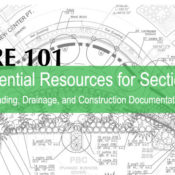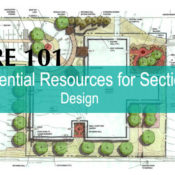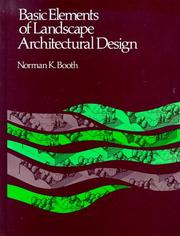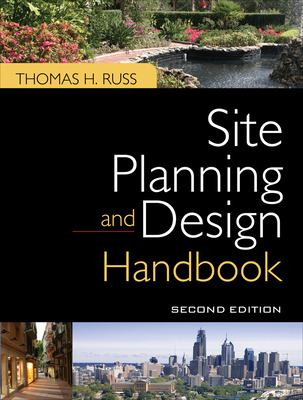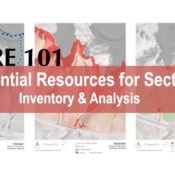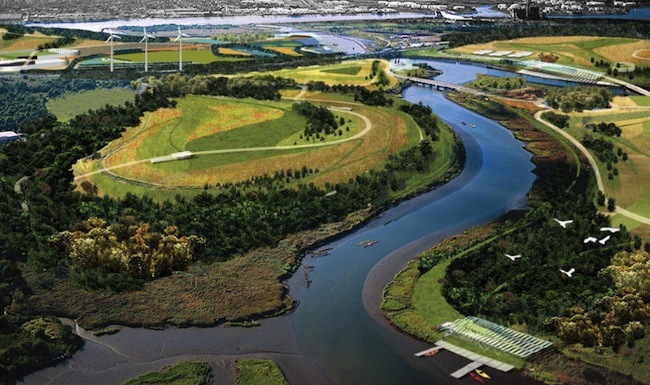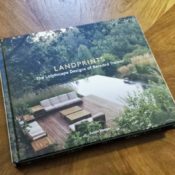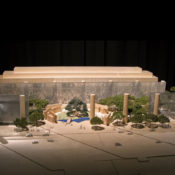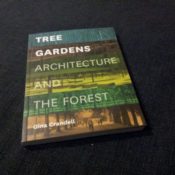Author: Benjamin Boyd
LARE 101: 10+ Essential Resources for Section 4 Grading, Drainage, and Construction Documentation
LARE’s Section 4: Grading, Drainage, and Construction Documentation is, in my opinion, the hardest portion of the exam. It has the lowest passing rate of any section – before and after the change in format. You will find in your preparation for this section that there is a wide range of topics that need to be covered, most of which you have seen, but probably haven’t mastered.
For me, the most difficult of the 120 questions were those pertaining to grading and specific construction details. I would encourage everyone who is thinking of taking Section 4 to give yourself a few months of studying in order to cover the wealth of material out there. There is only one year’s worth of up to date practice tests, but there is a lot you can take from previous incarnations. If you have already taken Section 3 then you are going to be familiar with the advanced question types that are present on this section. There is a lot of detail in this section so I would just be patient and expect to learn a bunch of information that may not show up on the test. That huge list of fasteners that you have to memorize may seem like overkill, but you can expect it to help you on at least one question (it did for me).
Before moving forward – please take a look at CLARB’s LARE Orientation Guide if you haven’t already.
SECTION 4 ONLINE RESOURCES
Because of the difficulty and breadth of Section 4, there are more than usual online resources for it. The ASLA has put out study guides and examples as well as the aforementioned video.
ASLA LARE Prep Study Materials
ASLA has provided a good amount of examples and guides for your Section 3+4 studying needs. They pin point some of the more difficult and multidimensional questions on the exam. These are provided for free as opposed to the practice tests listed further down. I would also like to spotlight their Section 4 Review Materials as a good starting resource.
LARE Exam Google Group
One of the best places on the Internet right now to get study materials as well as feedback on questions that you might have about the exam is the unofficial LARE EXAM Google group. Here hundreds of test takers as well as test prep professionals exchange exam tips and study materials.
L.A.R.E. – ANYTHING GOES Land8 Group
If you haven’t already joined Brandon Reed’s Land8 LARE group, what are you waiting for? This is also another fantastic resource for members to swap study materials and ask questions.
Digital Flash Cards
Using flash cards is one of my favorite ways to study, especially if they’ve been pre-made. Many people – including myself – have created personal study material flashcards that are ready to use. Making your own flashcards is a great way to study however, so I still encourage you to create your own set tailored to your own preferences. I would also recommend installing a flashcard app that links to a site like Cram so you have your cards on the go.
These are a must-have if you want the most accurate representation of topics covered in the new exam.
PPI: Power to Pass Exam Reviews
PPI has long provided test prep materials including practice exams and study guides. The books are written by professors and professionals in the industry and are a good overall resource to study for the new exam formats. They seem to have retrofitted their older Section A-E materials into a new package for Sections 1-4, however which may make the materials a little less accurate than before.
Kevin Worthington’s LARE Study Guides
Cheryl Corson Design Webinars
Land8 member Cheryl Corson is well known for her LARE webinars and her great advice for taking the LARE. Cheryl has a good focus on Section 4 and her personal experiences passing it.
Take a look and see if there is a test prep course in your area. Some colleges offer courses or you may be able to find a practitioner that is getting their side-hustle on.
SECTION 4 READING LIST
The Section 4 reading list has a few hold overs from Section 3, but adds one important text. Site Engineering is a very useful book that outlines a variety of topics that will be covered in the Section 4. All of the books on the below list are very large and, as with other tests, I would recommend a good study guide to accompany these. If you have given yourself enough time to go through each and take notes then you are ahead of the game. If not, then go out and pick up a study guide to help you outline your study targets.
Site Engineering for Landscape Architects | Strom, Nathan, Woland
Site Engineering is an essential book for understanding the actual construction of land forms. This book includes more recent details of green stormwater management options, a new focus of the test, as well as other complex construction concepts. Because of the new content of the 6th edition vs earlier editions, I would recommend picking up the newest book if possible. There is a more concerted focus on green infrastructure which coincides with the new versions of the test. Though I wouldn’t say the book is “intellectually stimulating” as the publisher does, I would say that the topics are important and this book is a must have for studying.

Landscape Architectural Graphic Standards | Hopper
While you should have a solid understanding of the contents of this book already. It never hurts to touch up on your graphical standards. For Section 4, the diagrams of common construction details can be very beneficial for studying. This book is also listed for Section 3: Design.
Time Saver Standards for Landscape Architects | Harris and Dines
This book is every landscape architect’s best friend. It will remind you of minimum turning radii, maximum slope on ramps, etc etc. However, it will also bog you down with a huge amount of information if you are not careful. As a former student, you should be familiar with this book. Pay careful attention to the topics provided by CLARB in the Orientation Guide and tailor your reading to it. If you don’t already own a copy then you should. Lest you spend over an hour searching the internet for angled parking standards. This book is also listed for Section 3: Design.
Landscape Architect’s Portable Handbook | Dines and Brown
Don’t let this book’s title fool you. At 400 pages and $65 the “portable” handbook is just as massive as some of the other books in this list. While if does do a nice job over quickly covering a variety of topics, I personally would not recommend it to those that are purchasing the above books. It outlines roughly some of the same things and doesn’t really add any sort of new material. At best, this book is a reduced version of Time Saver Standards. If are not able to get your hands on a copy of TSS, then this book may be a good substitute. However, if you are already covering the rest of this list then I would let this one slide.
RECOMMENDED STUDY METHODS FOR SECTION 4
Unlike Section 3, older vignettes are a good study resource for Section 4. The advanced type grading questions are roughly the same with addition of a possible answer bank and a computerized format. I would encourage you to take a look at the examples provided by ASLA mentioned in the “Study Materials” section. Section 4 is a monster of a test that covers the largest amount of material. For me, it was the only exam that I left feeling totally unsure of my result. As with other sections, you are only graded on the questions you get correct. However, there are many questions that require you to have solved a different question in order to answer it. Grading questions are one example of this. Take your time and try to no overthink your answers. You are inevitable going to come to a few questions that you don’t know the answer to. Take an educated guess, flag the question, and move on. Often there are clues in the rest of the exam that can help you go back and make a better choice.
Good luck!
This is part of an ongoing series spotlighting the Landscape Architecture Registration Examination (LARE) administered by the Council of Landscape Architectural Registration Boards (CLARB). If you have any resources that you can add to this guide we would be happy to include you and give you credit. Please contact the author Benjamin Boyd if you have any additional resources that you’d like to share.
LARE 101: 10+ Essential Resources for Passing Section 3 Design
LARE’s Section 3: Design is where, in my opinion, things start coming together. The last two sections are hard for a number of reasons. First, this section requires you to use multiple facets of your knowledge at one time to solve a problem. Second, Section 3 is the most changed in format from previous exams and there is less study material available to you. Lastly, test makers have a difficult job in testing creativity in a computer format. After looking at vignettes from previous years, I felt that Section 3 might actually be easier now as long as you don’t get hung up overthinking some of the questions. However, I cannot be sure because I haven’t taken the older format. Comparatively, this new format seems to push test takers to solve one specific problem at a time instead of a whole design at once.
Before moving forward – please take a look at CLARB’s LARE Orientation Guide if you haven’t already.
SECTION 3 ONLINE RESOURCES
This section is relatively the same at the others when it comes to online resources. There is a lot of useful information already explored by others. Take some time to seach about a question you are unsure of. Odds are someone else is looking at the same study guide or practice exam and has already raised the point.
LARE Exam Google Group
One of the best places on the Internet right now to get study materials as well as feedback on questions that you might have about the exam is the unofficial LARE EXAM Google group. Here hundreds of test takers as well as test prep professionals exchange exam tips and study materials.
L.A.R.E. – ANYTHING GOES Land8 Group
If you haven’t already joined Brandon Reed’s Land8 LARE group, what are you waiting for? This is also another fantastic resource for members to swap study materials and ask questions.
Digital Flash Cards
Using flash cards is one of my favorite ways to study, especially if they’ve been pre-made. Many people – including myself – have created personal study material flashcards that are ready to use. Making your own flashcards is a great way to study however, so I still encourage you to create your own set tailored to your own preferences. I would also recommend installing a flashcard app that links to a site like Cram so you have your cards on the go.
CLARB Practice Test
These are a must-have if you want the most accurate representation of topics covered in the new exam.
PPI: Power to Pass Exam Reviews
PPI has long provided test prep materials including practice exams and study guides. The books are written by professors and professionals in the industry and are a good overall resource to study for the new exam formats. They seem to have retrofitted their older Section A-E materials into a new package for Sections 1-4, however which may make the materials a little less accurate than before.
Kevin Worthington’s LARE Study Guides
Cheryl Corson Design Webinars
Land8 member Cheryl Corson is well known for her LARE webinars and her great advice for taking the LARE.
Take a look and see if there is a test prep course in your area. Some colleges offer courses or you may be able to find a practitioner that is getting their side-hustle on.
SECTION 3 READING LIST
Two of these books are straight repeats from Section 2 and one is, in my opinion, unnecessary. Because there is not definitive guide to all aspects of design, CLARB has thrown it’s biggest and widest reaching books into this section’s reading list. Here is where looking at the practice exams and a study guide can really give you an advantage by honing down your studying. If you want to build your own expansive study guide, my advise would be to use the first book on this list to frame it and the rest to supplement those topics. While most of my comments below may lead you to think that you don’t need any textbooks, please make sure you are are taking a real assessment of your own skill and studying accordingly.
Basic Elements of Landscape Architectural Design | Booth
This book is also mentioned for Section 2 and the same sentiment applies. It is a great resource to have whether you are studying for the test or not. The book breaks down landscape architectural concepts into simple graphics and explanations. Originally published in 1989, this book covers the gamut including “landform, plant materials, buildings, pavement, site structures, and water.”

Landscape Architectural Graphic Standards | Hopper
While you should have a solid understanding of the contents of this book already. It never hurts to touch up on your graphical standards. The test is going to make you draw, however, so I would not devote a significant percentage of your time to this book.
You should have already known about this book from Section 2 if you are taking the tests in order. There is a lot of repeated information that you can get from other sources. Given the price of the book, unless there is a way that you can borrow or rent it, I would try and find an assembled study guide rather than shell out so much for some of the same information. I do however feel that a lot of the concepts in this book are more applicable to Section 3 than Section 2.

The Dimensions of Parking | ULI
I am going to level with you here… I didn’t even crack open this book. Parking dimensions can be found in Time Saver standards and I didn’t feel the need to get into the “Financial Feasibility” of “Bidding Methods” of parking facilities. You are going to need to know a decent amount about parking requirements, layout, and safety in order to complete many of the advanced question types. If you are rusty or unsure of your parking knowledge then by all means this book is for you. However, if there is one $80+ book I personally didn’t need, it was this one.
Time Saver Standards for Landscape Architects | Harris and Dines
This book is every landscape architect’s best friend. It will remind you of minimum turning radii, maximum slope on ramps, etc etc. However, it will also bog you down with a huge amount of information if you are not careful. As a former student, you should be familiar with this book. Pay careful attention to the topics provided by CLARB in the Orientation Guide and tailor your reading to it. If you don’t already own a copy then you should. Lest you spend over an hour searching the internet for angled parking standards.
RECOMMENDED STUDY METHODS FOR SECTION 3
As you can probably tell from any of the up to date practice exams, older vignette’s are not going be as big a help as you might have thought. That is not to say you shouldn’t look over them. Instead of spending time trying to figure out the answers to each practice vignette on your own, try analyzing the answers first. Look for the key differences between a FAIL, BARELY PASS, and PASS. These differences are the things you should be paying close attention to. As with other sections, read as much as you can beforehand and then take the practice exams a couple times closer to the test date. This will allow for the greatest impact.
Good luck!
This is part of an ongoing series spotlighting the Landscape Architecture Registration Examination (LARE) administered by the Council of Landscape Architectural Registration Boards (CLARB). If you have any resources that you can add to this guide we would be happy to include you and give you credit. Please contact the author Benjamin Boyd if you have any additional resources that you’d like to share.
LARE 101: 10+ Essential Resources for Section 2 Site Inventory & Analysis
LARE’s Section 2: Site Inventory and Analysis at first glance is one of the easier sections because it is one of the most covered set of topics in school. However, the section covers topics that include a level of analysis that will require you to brush up on specific regulations and requirements and apply those in a critical manner on a wide range of exercises. Some of the information here is also applicable to others sections of the exam.
Before moving forward – please take a look at CLARB’s LARE Orientation Guide if you haven’t already.
SECTION 2 ONLINE RESOURCES
LARE Exam Google Group
One of the best places on the Internet right now to get study materials as well as feedback on questions that you might have about the exam is the unofficial LARE EXAM Google group. Here hundreds of test takers as well as test prep professionals exchange exam tips and study materials.
L.A.R.E. – ANYTHING GOES Land8 Group
If you haven’t already joined Brandon Reed’s Land8 LARE group, what are you waiting for? This is also another fantastic resource for members to swap study materials and ask questions.
Digital Flash Cards
Using flash cards is one of my favorite ways to study, especially if they’ve been pre-made. Many people – including myself – have created personal study material flashcards that are ready to use. Making your own flashcards is a great way to study however, so I still encourage you to create your own set tailored to your own preferences. I would also recommend installing a flashcard app that links to a site like Cram so you have your cards on the go.
CLARB Practice Test
These are a must-have if you want the most accurate representation of topics covered in the new exam.
PPI: Power to Pass Exam Reviews
PPI has long provided test prep materials including practice exams and study guides. The books are written by professors and professionals in the industry and are a good overall resource to study for the new exam formats. They seem to have retrofitted their older Section A-E materials into a new package for Sections 1-4, however which may make the materials a little less accurate than before.
Kevin Worthington’s LARE Study Guides
Cheryl Corson Design Webinars
Land8 member Cheryl Corson is well known for her LARE webinars and her great advice for taking the LARE.
Take a look and see if there is a test prep course in your area. Some colleges offer courses or you may be able to find a practitioner that is getting their side-hustle on.
SECTION 2 READING LIST
As with Section 1 of the test, I believe that a lot of the knowledge for this section is material that you covered in school. Most of the information in these books will be a refresher. See if there are any other low cost options such as the public library, your company purchasing the books, or renting. The first three recommended readings on this list from CLARB are large books filled with tons of information. A lot of that info is repeated and some feel that purchasing all of them is a waste of time. If you have your hands on a good study guide such as the PPI, I would recommend just getting one of the first three.
Basic Elements of Landscape Architectural Design | Booth
This book is great resource to have whether you are studying for the test or not. The book breaks down landscape architectural concepts into simple graphics and explanations. Originally published in 1989, this book covers the gamut including “landform, plant materials, buildings, pavement, site structures, and water.”
Site Analysis: A Contextual Approach to Sustainable Land Planning and Site Design
Site Analysis has a lot of the same information as the above book, just in much, much more detail. Some of this is also repeated in another gigantic textbook – Time Saver Standards. Unless you are starting to study months in advance, I would recommend using your money to invest in a good study guide rather than leaf through this entire to me.
The same can be said for this book as the one above it. There is a lot of repeated information that you can get from other sources. Given the price of the book, unless there is a way that you can borrow or rent it, I would try and find an assembled study guide rather than shell out so much for some of the same information.
The Living Landscape: An Ecological Approach to Landscape Planning
CLARB is really trying to integrate more sustainability into the LARE in recent years. Because of this, I would recommend picking up a copy of this book if possible. Older study guides do not cover as much “green” material and there is only one current practice exam at the time of this post. The checklists and step-by-step guides are particularly helpful to remember. While there wont be as many sustainability questions as there are simple analysis ones, this book is useful mostly because it isn’t the same book repeated 2 times (see above 3 books).
RECOMMENDED STUDY METHODS FOR SECTION 2
My process for studying for Section 2 closely resembled that of Section 1. I also took Sections 1 and 2 at the same time because they both require you to study the same way. Get your hands on a good study guide or read through the books and make your own. Flash cards are your friend here as much of the exam is subject/definition style and less problem solving. As with Section 1, wait until you have covered most of your study material before you jump into the practice exams since there is only one that is up to date.
Good luck!
This is part of an ongoing series spotlighting the Landscape Architecture Registration Examination (LARE) administered by the Council of Landscape Architectural Registration Boards (CLARB). If you have any resources that you can add to this guide we would be happy to include you and give you credit. Please contact the author Benjamin Boyd if you have any additional resources that you’d like to share.
Check out our guide to Section 1: Project and Construction Administration
LARE 101: 10+ Essential Resources for Section 1 Project & Construction Administration
For me, the LARE’s Section 1: Project & Construction Administration was one of the most daunting parts of the exam due to the fact that I don’t handle contracts on a regular basis. Consequently, Section 1 is also one of the hardest sections for new professionals to tackle because the topics deal with business and legal matters that they often have not yet experienced. An understanding of project management, however, proves incredibly beneficial and I was able to sufficiently prepare myself for the exam by supplementing my real life experience with the following study materials and tips.
The focus of Section 1 of the LARE is Project and Construction Administration with ‘Project Management’ covering 62% of the topics and ‘Bidding and Construction’ covering the remaining 38%. This is essentially a part of Section A of the old version of the test. While the topics are the same, this section, like the other three, is now completely computer-based. The entire section is also multiple choice. One benefit of the new computer-based test is the ability to flag a question so you can easily come back to it at a later time.
While the topics are the same as Section A, many test takers have noticed that there has been a shift in focus. All previous study materials are applicable, but I strongly recommend using the most up-to-date practice tests and rubrics. Many people have noticed that there is less focus on very specific topics such as the different types of liens or methods of payment. As with other sections of the LARE, Section 1 aims to make sure a licensure candidate has more of a understanding of the overall project process, different stages of design and construction, and
Before moving forward – please take a look at CLARB’s LARE Orientation Guide if you haven’t already.
SECTION 1 ONLINE RESOURCES
This is a list of general contract terms that can be on the exam. It is important to make sure that you understand client/contractor relationships, the contracting schedule of events, notifications to bid/proceed/etc, and the legal requirements to start/finish a project.
One of the best places on the Internet right now to get study materials as well as feedback on questions that you might have about the exam is the unofficial LARE EXAM Google group. Here hundreds of test takers as well as test prep professionals exchange exam tips and study materials.
L.A.R.E. – ANYTHING GOES Land8 Group
If you haven’t already joined Brandon Reed’s Land8 LARE group, what are you waiting for? This is also another fantastic resource for members to swap study materials and ask questions.
Using flash cards is one of my favorite ways to study, especially if they’ve been pre-made. Many people – including myself – have created personal study material flashcards that are ready to use. Making your own flashcards is a great way to study however, so I still encourage you to create your own set tailored to your own preferences. I would also recommend installing a flashcard app that links to a site like Cram so you have your cards on the go.
These are a must-have if you want the most accurate representation of topics covered in the new exam.
PPI: Power to Pass Exam Reviews
PPI has long provided test prep materials including practice exams and study guides. The books are written by professors and professionals in the industry and are a good overall resource to study for the new exam formats. They seem to have retrofitted their older Section A-E materials into a new package for Sections 1-4, however which may make the materials a little less accurate than before.
Kevin Worthington’s LARE Study Guides
Land8 member Cheryl Corson is well known for her LARE webinars and her great advice for taking the LARE.
Below I’ve listed CLARB’s reading suggestions for Section 1. If you are already feeling the hit to your wallet from the study guides and test fees, the last thing that you’ll want to do is spend an additional $300+ dollars for the below books. I would say that depending on your method of study, you should pick either the comprehensive study guides mentioned above or the books; it’s probably not necessary to buy both. Remember to check your company, school, or library to see if they have these books on hand or if they are willing to purchase them as additions to their library. If so, this is a great way to supplement your studying for free.
Construction Contracts, 2nd Edition / Hinze
This is probably one of the most useful books in this list as it outlines many concepts that most landscape architects do not use everyday. However, it was my conclusion that most of the very specific material covered in this book is not really mentioned on the exam. If you are confused about any of the legal aspects of contracts then this is definitely a book that you should look into. To pass section 1, you must have proficient knowledge of the process by which contracts are given and fulfilled. There is less emphasis on topics such as lien types and specific clauses for different circumstances.
Project Management for Design Professionals / Ramroth
Often required reading in college, this book outlines the different stages of project management in fine detail. Any professional will tell you that this process is often thrown out the window based on unique client demands and schedule. However, since all test takers will be working off the same rubric, this books is perfect for outlining the reasoning behind each method. Since 62% of the exam covers project management, I think that this book is an essential resource.
Ready, Set, Practice: Elements of Landscape Architecture Professional Practice / Sharky
Another mainstay of any collegiate level professional practice class, this book is a must read if you are not familiar with how a design-based business works. Topics in the book cover design process, client relations, and other topics that are tested on in the exam.
Sustainability and Design Ethics / Russ
This is a newer addition to the recommended reading list. I found that this book was not as conducive to studying, but it might be good to read through at least once to make sure you are familiar with the topics covered. CLARB is attempting to integrate sustainability into more areas of the exam (other than just design and construction) so do not be surprised when design ethics are brought up in Section 1. The books is fairly short and is rather expensive for its size. If you have a good study guide then this is a book I would omit.
RECOMMENDED STUDY METHODS FOR SECTION 1
To pass the LARE Section 1, you need to know the glossary of terms, read the textbook and take practice exams. My main method to prepare for Section 1 was to create a large collection of study flash cards.
Instead of writing notes from the text book, I would create a flashcard that asked a question based on the material that I was reading. This way, I could incorporate all of my notes into one personal flashcard test session. Using a flashcard app, I was able to test myself during any down time I had.
I also strongly recommend waiting as long as possible before taking the practice exams. They are a great resource, but if you take them cold without any studying, you won’t have a chance to assess how well you’ve prepared later on. My advice is to wait until two weeks before the exam to break into those practice tests. This will give you enough time to get acquainted with the types of questions that will be asked as well as double back on topics that you may have not comprehensively covered in your studies.
All this said, everyone studies differently, so it’s important to find a study method that is best suited for you. The LARE really tests application of the study topics as opposed to just the definition to some term. Critical thinking is a big component so your success in Section 1 hinges on how well you can explain how the design process works, both from a project management standpoint as well as from the stance of a contractor.
Good luck!
This is part of an ongoing series spotlighting the Landscape Architecture Registration Examination (LARE) administered by the Council of Landscape Architectural Registration Boards (CLARB). If you have any resources that you can add to this guide we would be happy to include you and give you credit. Please contact the author Benjamin Boyd if you have any additional resources that you’d like to share.
Check out our guide to Section 2: Site Inventory and Analysis
James Corner Unveils Plans to Build NYC’s Largest Solar Energy Installation into Fresh Kills Park
Fresh Kills Park, once the world’s biggest landfill, is once again making waves thanks to outgoing Mayor Bloomberg’s recent announcement to add 35,000 solar panels to Fresh Kills Park. Nearly three times the size of Central Park, Fresh Kills is an ongoing large-scale reclamation project in Staten Island led by James Corner Field Operations. Slated to “become a showcase (of) urban renewal and sustainability,” the park will soon be home to New York’s largest source of solar power.
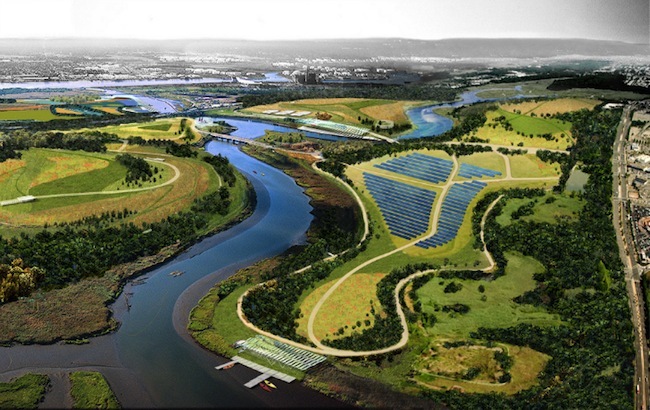 The solar installation would be capable of generating up to 10 megawatts of power – enough to run about 2,000 homes. According to a statement by the Office of the Mayor, the solar array will double the City’s current renewable energy capacity. The renewable energy investment is also part of the PlaNYC initiative, NYC’s long-term sustainability blueprint to cut down on greenhouse gas emissions.
The solar installation would be capable of generating up to 10 megawatts of power – enough to run about 2,000 homes. According to a statement by the Office of the Mayor, the solar array will double the City’s current renewable energy capacity. The renewable energy investment is also part of the PlaNYC initiative, NYC’s long-term sustainability blueprint to cut down on greenhouse gas emissions.
From the press release:
“Freshkills was once the site of the largest landfill in the world. Soon it will be one of the City’s largest parks, and the site of the largest solar power installation ever developed within the five boroughs,” said Mayor Bloomberg. “Over the last twelve years we’ve restored wetlands and vegetation and opened new parks and soccer fields at the edges of the site. Thanks to the agreement today we will increase the amount of solar energy produced in New York City by 50 percent and it is only fitting that Freshkills, once a daily dumping ground, will become a showcase urban renewal and sustainability.”
Fresh Kills Park represents a 30 year process by which New York City plans to change a massive collection of it’s own refuse into a rolling landscape equipped with ample active open space adjacent to one of the densest places in the modern world. The plan consists of 6 phases that outline both the process of trash decomposition and management as well as the establishment of staged plant communities.
You can read more about the history of this park’s development here.
Photos courtesy of James Corner Field Operations
Book Review: Landprints: The Landscape Designs of Bernard Trainor
Landscape Architect Bernard Trainor designs pastoral and coastal projects on the California coast and countryside. His projects use native plant palettes, recycled materials, and a ever-so delicate touch that almost makes you think that a stunning view of a rocky coastal bay had been that way all along. His appropriately titled book, LANDPRINTS, takes us on a tour of Trainor’s ten most ambitious projects. The landscapes are indeed beautiful and reflect how working with nature, instead of imposing a strict design, can ultimately yield a wonderful result.
Growing up in Australia, Bernard Trainor was influenced in a way that has carried throughout his work. The wilderness, with its innate honesty reflected in texture and pattern, resonated with him and thus Trainor, “made it his life’s work to honor California’s spirit in gardens across the state.”
His projects read like picturesque postcards you might see from California. A scenic bay flanked by jagged cliffs with an modern home sitting blissfully amongst the rocks. These are the projects Trainor is attracted to. And who wouldn’t be? When a designer is given a masterpiece to work with often the greatest challenge is not to mess it up. Like any good museum housing priceless pieces of art, a poor presentation can ruin it for the viewer. Trainor uses a delicate hand to make living amongst these natural wonders feel seamless.
“I want my gardens to connect seemlessly with the surrounding plant communities; to look as they were meant to be,” says Trainor: “Nature is not a place to visit – it is home.” – Gary Snyder, poet
Trainor believes that it is a losing proposition to impose strict geometries on irregular, naturalistic sites. “My designs,” he notes, “are not based on any simple point or perspective. They respond to the complexity onsite and work with it to make landscapes harmonize with the bigger picture.”
While there are many lessons that can be gleaned from his work, finding the right situation to apply them takes some consideration and talent which Trainor himself has mastered and is clearly showcased in his book, LANDPRINTS: The Landscape Designs of Bernard Trainor.
All images by author. Please do not use without permission.
Revised Gehry Design Approved by Eisenhower Commission
The Eisenhower family criticized the original design as invoking images of Soviet mythmaking and Nazi-era barbarism. The family did not attend the Tuesday meeting but is expected to weigh in on the new design before the commission meets again, possibly within a week. At that meeting, the commission is expected to decide whether to send the plan forward to the National Capital Planning Commission.
Planners hope to break ground on the four-acre memorial this year. Projected to cost an estimated $110 million, the memorial would be bisected by Maryland Avenue SW, just south of the Mall and would be situated in front of the Education Department and across from the National Air and Space Museum — buildings that tie in with Eisenhower’s legacy.
Book Review: Tree Gardens: Architecture and the Forest
Tree Gardens: Architecture and the Forest, written by Gina Crandell, is a sweeping exploration of projects that changed the way we think about trees in the landscape. Beginning with the wooded defense embankments of Renaissance Lucca, Italy and reaching to the powerful Memorial Forest of New York’s 9/11 Memorial, Tree Gardens examines not only the experience of each garden, but also the hidden story of care and nurturing that they have endured. The gardens of the book tell a story of an artistic statement whose success is measured not by the fashion of the day, but by the ever changing effects of time.
Tree Gardens outlines 15 projects that exemplify the idea that trees and their arrangements can become the architecture of a garden. Crandell explores the different impetuses for the gardens construction – defensive fortifications in Lucca, vanity in the case of Versailles, and the adaptive reuse of a airport in Munich.
Maintenance and Longevity
As an idea, trees in groves and tight arrangements are some of the most difficult designs to pull off. Trees when planted are often not as big as reflected in the original design and it takes years to grow to maturity. On top of this, as the trees age the growth becomes more dense and interior space makes sustaining growth year after year difficult. The book explores the many ways that designers have addressed maintenance and how the sites have been altered over time to react to the obstacles of growth.
Versailles is an interesting case study because of its polarized historical significance. To many, cutting down a 100 year old tree seems like a crime against nature. However, many trees are reaching the end of their life cycle at about that age and it benefits the rest of a design to sometimes remove and replant. Versailles has done an exemplary job of this and subsequently the towering walls of growth keep their original intention.
One instance where a proper maintenance schedule was not maintained is Dan Kiley’s Gateway Memorial Park. According to Crandell, “Kiley employed various spacing schemes for the massing of particular species to draw attention to the tree’s character. These sculptural masses then perform spacial functions within his landscapes, such as compression and expansion.” Due to budget cuts and changes made by the National Park Service – some species and spacing of trees were changed. These and other problems negatively affect the design envisioned by Kiley – an issue that will hopefully be resolved in the new design by Michael Van Valkenburg and Associates.
Modern Tree Gardens
While Tree Gardens explores a few historical precedents, the meat of the book is about more modern projects. Crandell aims to show how contemporary landscape architects are utilizing the impact of tree form to create spaces for the next generation of open spaces. One of the themes of many of these projects is a large swath of space that is dominated by a monoculture tree grid. The 9/11 Memorial, Reimer Park, Oerliker Park, Parc de l’Ancien Palais, and Novartis Headquarters all utilize this convention with varying degrees of success. And while the impact of these bosques is immense, one cant help but wonder if designers are evoking the same generational design trend. The advantage of such design is that the rest of a scheme’s elements seem to be emphasized in their derivation from the grid. However, trees can also make a similar architectural impact in a more curved scheme such as Van Valkenburg’s Brooklyn Bridge Park. It seems that a grid can be the solution when immersion is the goal whereas forms that flank a space can give importance to a view.
Gina Crandell currently practices landscape architecture in Brookline, MA. She has previously taught at the Harvard Graduate School of Design, the University of California at Berkeley, Iowa State University and the Rhode Island School of Design. The American Society of Landscape Architects honored Crandell with the Award of Excellence in 2006 and the Bradford Williams Medal in 1984.
Originally posted at Landscape Invocation


